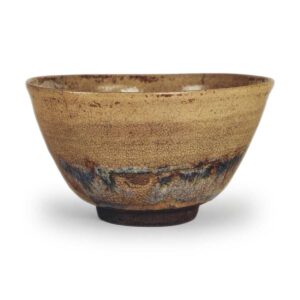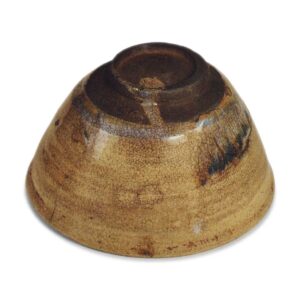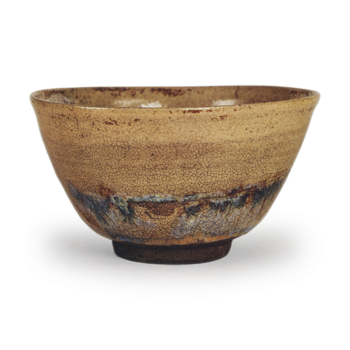

Chuko Meibutsu
Collection: Goto Museum of Art
Height: 8.7 – 8.8 cm
Diameter: 15.0 – 15.8 cm
Outer diameter of foot ring: 5.9 cm
Height of foot ring: 0.7 cm
This tea bowl, along with the Sekido family collection of Hon’ga and other tea bowls with the Okuda, Kuchiki, and Toki marks, is a so-called Chuko meibutsu (famous tea bowl from the middle of the Edo period) that was highly praised by Kobori Enshu, and was designated as an Important Art Object in July 1933, along with the Okuda tea bowl. Like the Okuda, it has a large, imposing appearance, and the promised loquat-colored glaze is moist and lustrous, giving it a deep, calm atmosphere. As promised, the nakago-iro glaze flows down in icicle-like drops from a crack in the center of the body to the foot of the bowl, but the part of the glaze that has broken off near the foot of the bowl is thick and dense, giving it a gorgeous opal-like sheen, and the glaze also flows down in a single line to the back of the foot of the bowl, making it more scenic than other Hakuans. The exposed clay on the foot ring and the foot ring itself are made of a slightly coarse iron-colored clay, and the foot ring is knotted like bamboo, the tatami-mats are unevenly wide and narrow, and the center of the foot ring is shaped like a fan, as is common in Hakuan ware. However, the wide and narrow parts of the raised tatami mat surface, which is thin on one side, are very pronounced, like the crescent shape often seen on Karatsu pottery bowls.
The lathe marks are clearly visible on the inside of the bowl, just as they are on the outside, and they are particularly noticeable around the tea pool in the center of the bowl, where there are several large and small sea-shell patterns.
The appearance of the nakago glaze in the tea-drip area is similar to that of the Okuda Haku-an, but there are more of them than on the Okuda, so the scenery of the interior is even more gorgeous. The pronounced traces of the potter’s wheel are similar to the dynamic feel of the well tea bowl, and the rich variation of the glaze on the inside and outside gives it a sense of elegance. This is probably why the Haku-an tea bowl has been particularly highly regarded since ancient times.
Inner box: paulownia wood, with the inscription “Seto Haku-an teacup” on the lid by Kobori Enshu
Outer box: black lacquer, with the inscription “Seto teacup Haku-an” on the lid in blue shell by Matsudaira Fumai
In addition, a calligraphy by Ryoen is also included in a paulownia wood box with the inscription by Matsudaira Fumai.
The name “Fuyuki” was originally given to this tea bowl because it was owned by the wealthy Fuyuki family of Fukagawa, Edo. It was later passed on to the Horita Sagami no Kami, lord of the Sakura castle in Shimousa Province, and then to Taru Yozaemon, a resident of Edo, and then to the Matsudaira Fumai family, lord of the Matsue castle in Izumo, who owned it during the Kansei era. After the Second World War, however, it left the family. In addition to this bowl, the Matsudaira family also had a “Okuda” bowl in their collection, but it is said to have followed a similar path to the “Fuyuki” bowl and is now in the collection of a certain tea ceremony enthusiast in Tokyo.



